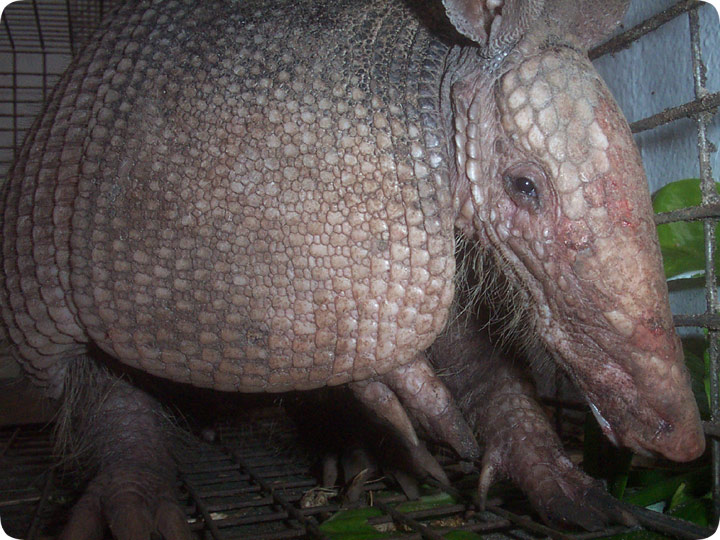-
info@aaanimalcontrol.com
Call us for help in your town
Humane Wildlife Education
Closeup Photograph of an Armadillo

03.03.2005 - I am very pleased with this closeup photo of a handsome armadillo. Truly one of nature's loveliest creatures. Some like the colorful feathers
of the peacock, or the happy smile of a bottlenose dolphin, or the cute fluffiness of a kitten, but no one can deny the rugged good looks of the Nine Banded
Armadillo. Just look at that bright and inquisitive eye, or that smooth skin. How about that cute little beard, or those adorable feet? Some animals were
built for rugged utility, and some were built for pure cuteness, and I have to say that the armadillo rates at least a 9.5 on the adorable scale. If you want
a picture of an armadillo for your website, or an armadillo photograph for your bedroom wall or bathroom, I grant you permission to use this photo that I've
taken. Just don't look at it for too long, or you could fall in love.
Armadillo Photo Gallery: Visit my Armadillo Photo Gallery page for 24 high-resolution photos.
If you want to solve an armadillo problem:
Do it yourself: Visit my How To Get Rid of Armadillos page for tips and advice.
Get professional help: Visit my Nationwide Pro Directory of wildlife removal experts.
Pictures And Information About Armadillos - The armadillo is a fascinating creature that originated in the warm swampy areas of South America, but is now a common animal that is found across much of the United States and Central America too. The most distinctive feature of the armadillo is the tough armored hide which is its most important protection from predators, and this is made of plates of bone that are linked together by a tough horned skin. This has meant that the armadillo doesn?t really have many natural predators in North America, and has helped the population to flourish in this area where it isn?t a native species.
Armadillos aren?t always an animal that is welcome in many areas, as it can become a pest when it starts to root through garbage and is also known to dig up gardens and lawns looking for insects to eat. This is one of the reasons that there are many people who will actively look to get rid of armadillos or to prevent them from getting into their gardens in the first place. There are a number of excellent resources online to find pictures of armadillos, the most common of which is the nine-banded armadillo which is to be found across the country.
For more wildlife stories, click my Wildlife Blog
or click my below banner to hire a local trapper.
Armadillos are among the United States' most interesting critters. Their odd appearance really makes them intriguing to those who do not live around them. Those people who live around them see them as pests and don't appreciate them very much. Like them or not, armadillos are unique, and this article is meant to describe the armadillo's appearance and biology.
Appearance
The armadillo commonly found in the United States is roughly the same size as a big house cat or an opossum. Armadillos have a large, banded shell that protects them from many different predators. The downside to this for the little creatures is that their belly is composed of soft, hairy skin. Predators simply flip them over and attack the soft belly. The males weigh around 15 pounds and the females weigh around 10, as a rough average. The armadillo can be as long as 32 inches or as short as 24, of which the tail is around 12 inches. These interesting critters can be a brown-yellow or a dark brown color. They have hog-like noses, long ears, and long claws on their feet. They are classified with both sloths and anteaters, making them an incredibly unique animal for the United States.
Range
The armadillo started out in the early 1900s in Texas. From Texas, they moved into Louisiana, then to Georgia, spreading clear over to Florida. They more than likely won't go far into Appalachia, as they dislike the cold. They are also commonly found in Kansas, Oklahoma, Missouri, South Carolina, and Tennessee. Only time will tell how much farther these critters will spread.
Habitats
Armadillos are commonly seen rooting around in the ground. By using their long claws, they can quickly dig a sufficient burrow network that will protect them and their young. They like to dig around sheltered areas, for added protection to their burrow. Fallen logs, large stumps, and large rocks all make ideal sheltered areas.
Food
Armadillos enjoy looking for both insects and vegetables. More often than not, they are insectivores, however, if they see easy vegetable matter to consume, they will. They eat wasps, moths, beetles, ants, worms, snails, and have even been found to eat lizards, snakes, frogs, and salamanders. To find all of these insects, they love to root around in the ground. This is what often makes them a pest animal to most homeowners, as they get tired of having their yard or garden destroyed.
Behavior
If you thought dogs and cats were the only animals to mark their territory, think again. Armadillos use secretions from one of their glands that alerts other armadillos to their presence. These unique creatures are actually very good at climbing, and while they don't climb trees, they commonly cross rivers by climbing on fallen trees. If the armadillo senses danger, many times it will jump into the air before running quickly away. They are commonly seen walking very slowly with their nose to the ground, looking for insects. They snap up these insects with their sticky tongues and can dig quickly if they have to. All in all, armadillos are incredibly unique animals that are common pest animals, as they have the tendency to tear up yards.




















